重大信号与系统作业
北交20春《信号与系统》在线作业二_答案

(单选题)1: 当输入信号的复频率等于系统函数的零点时,系统的强迫响应分量为()。
A: 无穷大
B: 不为零的常数
C: 0
D: 随输入信号而定
正确答案: C
(单选题)2: 满足傅氏级数收敛条件时,周期信号f(t)的平均功率()。
A: 大于各谐波分量平均功率之和
B: 不等于各谐波分量平均功率之和
C: 小于各谐波分量平均功率之和
D: 等于各谐波分量平均功率之和
正确答案: D
(单选题)3: 卷积δ(t)*f(t)*δ(t)的结果为()。
A: δ(t)
B: δ(2t)
C: f(t)
D: f(2t)
正确答案: C
(单选题)4: 信号的时宽与信号的频宽之间呈()。
A: 正比关系
B: 反比关系
C: 平方关系
D: 没有关系
正确答案: B
(单选题)5: 设一个矩形脉冲的面积为S,则矩形脉冲的傅氏变换在原点处的函数值等于()。
A: S/2
B: S/3
C: S/4
D: S
正确答案: D
(单选题)6: 线性系统具有()。
A: 分解特性
B: 零状态线性
C: 零输入线性
D: 以上全对
正确答案: D
(单选题)7: 如果一连续时间二阶系统的系统函数H(s)的共轭极点在虚轴上,则它的h(t)应是()。
信号与系统 陈后金 第二版 课后习题答案(完整版)
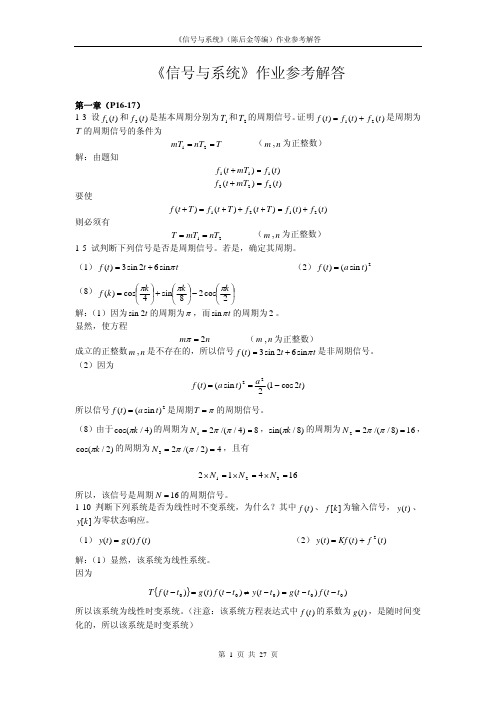
(1) f (t) = 3sin 2t + 6 sinπ t
(2) f (t) = (a sin t) 2
(8)
f
(k)
=
cos⎜⎛ ⎝
πk 4
⎟⎞ ⎠
+
sin⎜⎛ ⎝
πk 8
⎟⎞ ⎠
−
2
cos⎜⎛ ⎝
πk 2
⎟⎞ ⎠
解:(1)因为 sin 2t 的周期为π ,而 sin πt 的周期为 2 。
显然,使方程
−∞
0
2-10 已知信号 f (t) 的波形如题 2-10 图所示,绘出下列信号的波形。
f (t)
2
1
−1 0
t 2
题 2-10 图
(3) f (5 − 3t) (7) f ′(t) 解:(3)将 f (t) 表示成如下的数学表达式
(5) f (t)u(1 − t)
由此得
⎧2
f
(t)
=
⎪ ⎨ ⎪ ⎩
f (t)u(1− t) 2
1
0.5
t
−1 0
1
(7)方法 1:几何法。由于 f (t) 的波形在 t = −1处有一个幅度为 2 的正跳变,所以 f ′(t) 在 此处会形成一个强度为 2 的冲激信号。同理,在 t = 0 处 f ′(t) 会形成一个强度为 1 的冲激信 号(方向向下,因为是负跳变),而在 0 < t < 2 的区间内有 f ′(t) = −0.5 (由 f (t) 的表达式可
第 1 页 共 27 页
《信号与系统》(陈后金等编)作业参考解答
(2)显然,该系统为非线性系统。 由于
T{f (t − t0 )}= Kf (t − t0 ) + f 2 (t − t0 ) = y(t − t0 )
信号与系统 于敏慧(第二版)第二周作业答案
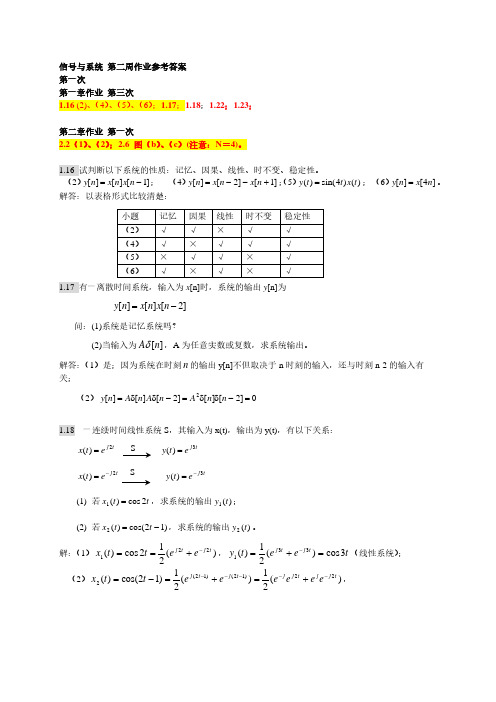
y0(t)
1
t
0
2
4
(6) x(t) = dx0 (t) , h(t) = dh0 (t) 。
dt
dt
x(t) * h(t) = dx0 (t) * dh0 (t) = d 2 y0 (t)
dt dt
dt 2
x(t) ∗ h(t) = 0.5δ(t) − 0.5δ(t − 2)
2.10 求 y[n] = x1[n]* x2[n]* x3[n] 。 其 中 x1[n] = (0.5)n u[n] , x2[n] = u[n + 3] 和
(2)利用(1)的结果,求系统的逆系统的单位样值(脉冲)响应。
(3)利用(2)的结果,结合卷积性质,求一信号 x[n],使之满足
x[n]* h[n] = 2n (u[n] − u[n − 4])
解:(1) h[n] − Ah[n −1] = δ [n],其中 h[n] = (1 )n u[n] , 2
(通项: an = a1q n−1 )
n
∑ 此题: a1 = 1, q = 2 ; x[n]* h[n] = 2nu[n]*u[n] = ( 2k )u[n] = (2n+1 −1)u[n] k =0
2.6 计算图 2-45(b)与(c)所示信号 x(n)与 h(n)的卷积和,注意:N=4。 解:(b)利用脉冲信号δ(n)的卷积性质以及卷积的延时性质计算:
k =−∞
+ 3] =
u[n + 3] 0.5k
k =0
;
= 2(1 − 0.5n+4 )u[n + 3]
(2) x1[n]* x2[n]* x3[n] = 2(1 − 0.5n+4 )u[n + 3]* (δ [n] − δ [n −1]) ; = 2(1 − 0.5n+4 )u[n + 3] − 2(1 − 0.5n+3 )u[n + 2]
信号与系统仿真作业

nGDOU-B—11—112广东海洋大学学生实验报告书(学生用表)课程名称课程号学院(系)信息学院专业班级学生姓名学号实验地点04002 实验日期实验一连时间信号的MATLAB表示和连续时间LTI系统的时域分析一、实验目的1.掌握MA TLAB产生常用连续时间信号的编程方法,并熟悉常用连续时间信号的波形和特性;2.运用MATLAB符号求解连续系统的零输入响应和零状态响应;3.运用MATLAB数值求解连续系统的零状态响应;4.运用MATLAB求解连续系统的冲激响应和阶跃响应;5.运用MATLAB卷积积分法求解系统的零状态响应。
二、实验原理1. 连续信号MATLAB实现原理从严格意义上讲,MA TLAB数值计算的方法并不能处理连续时间信号.然而,可用连续信号在等时间间隔点的取样值来近似表示连续信号,即当取样时间间隔足够小时,这些离散样值能够被MATLAB处理,并且能较好地近似表示连续信号.MATLAB提供了大量生成基本信号的函数.比如常用的指数信号、正余弦信号等都是MATLAB的内部函数。
为了表示连续时间信号,需定义某一时间或自变量的范围和取样时间间隔,然后调用该函数计算这些点的函数值,最后画出其波形图.三、实验内容1.实例分析与验证根据以上典型信号的MA TLAB函数,分析与验证下列典型信号MA TLAB程序,并实现各信号波形图的显示,连续信号的图形显示使用连续二维图函数plot().(1)正弦信号:用MA TLAB命令产生正弦信号2sin(2/4)ππ+,并会出时间0≤t≤3的波形图。
程序如下:K=2;w=2*pi ;phi=pi/4;t=0:0.01:3;ft=K*sin (w*t+phi );plot(t,ft ),grid on ;axis ([0,3,-2。
2,2.2])title (’正弦信号’)(2) 抽样信号:用MA TLAB 中的sinc(t)函数命令产生抽样信号Sa(t),并会出时间为66t ππ-≤≤的波形图。
信号与系统第一章习题及作业(1,2)
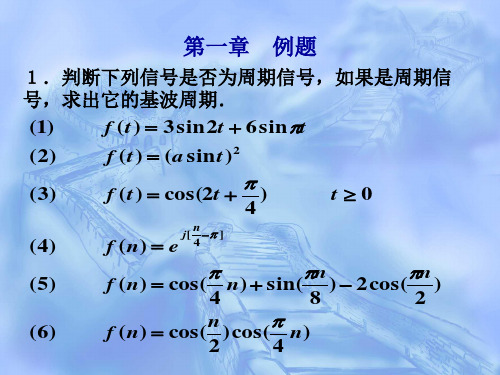
(2)(余弦序列是否为周期信号,取决于2л/Ω0是正整 (余弦序列是否为周期信号,取决于 Ω 有理数还是无理数。) 数、有理数还是无理数。) 因此, 因此, 2л/Ω0=2л·7/8л=7/4=N/m Ω =2л·7/8л 所以基波周期为N=7; 所以基波周期为N=7; N=7
因为2л/Ω =16л 为无理数, (4) 因为 Ω0=16л,为无理数,则此信号不是周期 信号. 信号. (5) 因为周期信号在[-∞,+∞]的区间上,而本题的重 因为周期信号在[ ∞,+∞]的区间上, 的区间上 复区间是[0, +∞],则此信号为非周期信号 则此信号为非周期信号, 复区间是[0, +∞],则此信号为非周期信号,
f(n) 1 0 3 6 … n
9、判断是否为线性系统?为什么? 、判断是否为线性系统?为什么?
( 3) ( 5) (7 )
y( t ) = ln y( t 0 ) + 3t 2 f ( t ) y( t ) = y( t 0 ) + f 2 ( t ) y( t ) = sin t ⋅ f ( t )
8、一个连续时间系统的输入-输出关系为 、一个连续时间系统的输入 输出关系为
1 t+T y ( t ) = T [ f ( t ) ] = ∫ T2 f (τ )d τ T t− 2 试确定系统是否为线性的?非时变的?因果的? 试确定系统是否为线性的?非时变的?因果的?
解:积分系统是线性的,因此系统是线性系统。 积分系统是线性的,因此系统是线性系统。
sin ω 0 tε ( t )
sin ω 0 ( t − t 0 )ε ( t )tt0 Nhomakorabeat
sin ω 0 tε ( t − t 0 )
北理工-信号与系统-第三版-第三章-作业参考答案
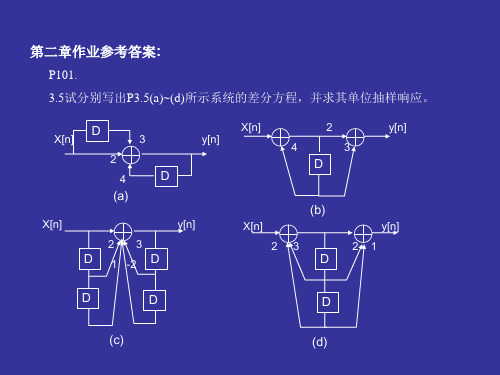
k
| u[k ] | ,有界
是非稳定系统
(e) 显然n<0时,h[n]=0,所以是因果系统;
k
| h[k ] | | u[k ] / n | ,无界
k
是非稳定系统
(f) 显然n<0时,h[n]=0,所以是因果系统;
| h[k ] |
(d)
y[n] x[n] h[n]
k
[k n ] [n k n ]
1 2
[n n1 n2 ]
3.11在LTI离散时间系统中 已知x[n]=u[n]时的零状态响应(单位阶跃响应)为s[n],求单位抽样响应h[n]; 已知h[n],求s[n].
y[n] - 4y[n-1] =2x[n]+3x[n-1];
令x[n]=δ[n],则有 h[n] – 4h[n-1] =2 δ[n]+3 δ[n-1];当n<0时,h[n]=0,得h[0]=2,h[1]=11,
特征方程为 λ-4=0, 得λ=4,
h[n]=c(4)nu[n],由h[1]=4c=11,c=11/4得 h[n]=(11/4)(4)nu[n-1]=11 (4)n-1u[n-1],考虑h[0]=2=2 δ[n],得 h[n]=2 δ[n]+11 (4)n-1u[n-1]。(n>0的解) (b).据图有同(a)一样的结果…。 (c).据图 y[n]=3y[n-1]- 2y[n-2]+ x[n]+2x[n-1]+x[n-2] ,即差分方程为 y[n] -3y[n-1]+2y[n-2] = x[n]+2x[n-1]+x[n-2], 先求
信号与系统课后答案第八章作业答案后半部分
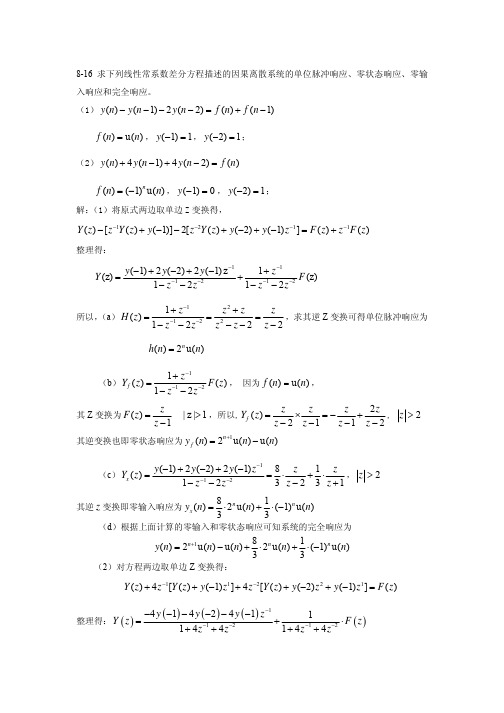
频率响应为
H
(e jΩ
)
=
H
(z)
|z = e jΩ
=
4 ⎡⎣ejΩ −1⎤⎦
3
⎡⎢⎣e
jΩ
−
1 3
⎤ ⎥⎦
经计算得极点为 p = 1 ,零点为 z = 1。 3
H(e jΩ)
(Ω)
幅频响应图(横坐标进行了归一化处理)
(c)Yx (z) =
y(−1) + 2 y(−2) + 2 y(−1)z−1 1− z−1 − 2z−2
=
8⋅ z +1⋅ 3 z−2 3
z, z +1
z
>2
其逆
z
变换即零输入响应为
yx
(n)
=
8 3
⋅
2n
u(n)
+
1 3
⋅
(−1)n
u(n)
(d)根据上面计算的零输入和零状态响应可知系统的完全响应为
f (n) = (−1)n u(n) , y(−1) = 0 , y(−2) = 1;
解:(1)将原式两边取单边 Z 变换得,
Y (z) −[z−1Y (z) + y(−1)] − 2[z−2Y (z) + y(−2) + y(−1)z−1] = F (z) + z−1F (z)
整理得:
Y (z)
=
题图 8-23
根据系统框图可得 h(n) = h1(n) ∗[h2 (n) + h3 (n)] ,故 h(n) = δ (n) ∗[h2 (n) + h3(n)] = u(n) + u(n − 2)
信号与系统课后答案(第二版)+曾禹村+第二章作业参考答案
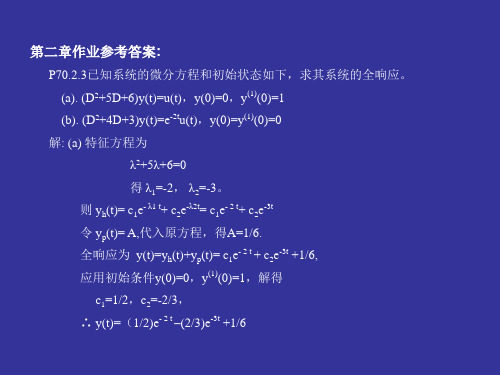
i1(t) = i2 (t) + i3 (t) , i2 (t) R2 − L 有 8i2 `(t) + 3i2 (t) = 2e`(t) ˆ ˆ 由 h`(t) + 3h(t) = 2δ (t)
0
h
(−1) t 3
T
t
t 3E − τ E (t) = ∫ δ (τ )dτ − ∫ e 8 u(τ )dτ −∞ 4 −∞ 32
x(t)
1
2 t
yx(t)
1 2 3 4 t
0
1
0
Qh(0) = 0, t ≤ 0, 有 0 ≤ t <1 , h(t) + h(t −1) + h(t − 2) = h(t) = t 时 1≤ t < 2时 h(t) + h(t −1) + h(t − 2) = h(t) + h(t −1) =1 , h(t) =1− h(t −1) =1− (t −1) = 2 −t 2 ≤ t < 3 , h(t) + h(t −1) + h(t − 2) =1 时 h(t) =1− h(t −1) − h(t − 2) =1− (2 − (t −1)) − (t − 2) = 0 3 ≤ t < 4时 h(t) = 4 − t − h(t −1) − h(t − 2) =4 −t − 0 − (2 − (t − 2)) = 0 , t, 0 ≤ t < 1 ∴h(t) = 2 − t, 1 ≤ t ≤ 2 0, t < 0,2 < t
解: (e) 特征方程为 λ2+4λ+4=0 得 λ1=-2, λ2=-2。 则 h(t)= (c1eλ1 t+ c2eλ2t)u(t)=( c1e- 3 t+ c2e-2 t)u(t) h`(t)= (c1+ c2)δ(t)+(-3c1e- 3 t-2c2e- 2t)u(t) h``(t)= (c1+ c2)δ`(t)+(-3c1-2c2) δ(t)+ (9c1e- 3 t+4c2e- 2t)u(t) 将x(t)= δ(t), y(t)=h(t)代入原方程得:
信号与系统课后答案第三章作业答案
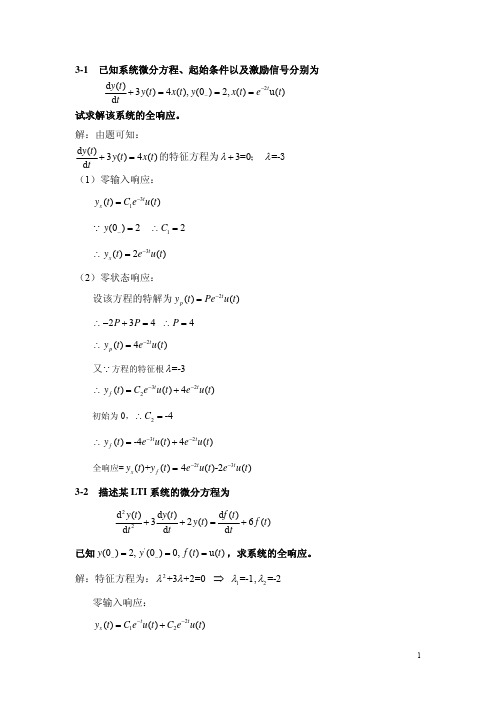
初始为 0, C2 -4
y f (t) -4e3tu(t) 4e2tu(t)
全响应= yx (t)+y f (t) 4e2tu(t)-2e3tu(t)
3-2 描述某 LTI 系统的微分方程为
d2 y(t) dt 2
3dy(t) dt来自2y(t)
df (t) dt
6
1
1
(2e1 e1 et ) u(t)
e1(2 et ) u(t)
(2)
f
(t)
a[u(t
s) 2
u(t
2)]
h(t) b[u(t 2) u(t 3)]
f
(t)
h(t)
ab[(t
1 2
)
u(t
1 2
)
(t
1 2
)
u(t
1) 2
tu(t)
1 4
(et
e3t
)u(t)
1 2
t
e3tu(t)
[
1 4
et
(
1 2
t
1 4
)e3t
]u
(t)
3-19 一 个 LTI 系 统 , 初 始 状 态 不 祥 。 当 激 励 为 f (t) 时 其 全 响 应 为
(2e3t sin 2t)u(t) ;当激励为 2 f (t) 时其全响应为 (e3t 2sin 2t)u(t) 。求
(1) 初始状态不变,当激励为 f (t 1) 时的全响应,并求出零输入相应、
零状态响应; (2) 初始状态是原来的两倍、激励为 2 f (t) 时系统的全响应。
信号与系统大作业模板
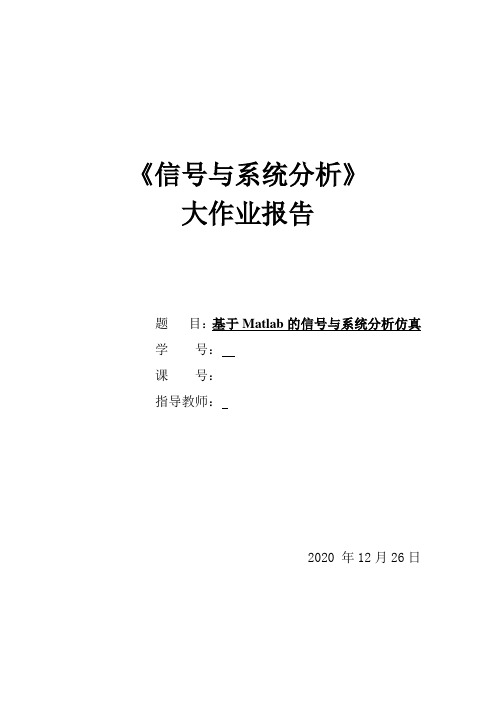
《信号与系统分析》大作业报告题目:基于Matlab的信号与系统分析仿真学号:课号:指导教师:2020 年12月26日一、设计思路:1.编写程序(函数),利用Matlab画出波形,并利用自变量替换方式实现信号的尺度变换、翻转和平移等运算;2.利用Matlab的impluse函数和step函数分别求解连续系统的冲激响应和阶跃响应,绘图并与理论值比较,利用卷积和函数conv计算连续时间信号的卷积,并绘图表示;3.利用函数quad和quadl求傅里叶变换,画出对应频谱,进行比较,验证尺度变换、时移、频移、卷积定理、对称性等性质;4.画出波形,利用quad函数或quadv函数求波形傅里叶级数,绘制单边幅度谱和单边相位谱,然后合成波形。
二、项目实现:1.信号的运算(1)编写程序(函数),画出图(a)所示波形f(t)(2)利用(1)中建立的函数,通过自变量替换的方式依次画出图(b)、(c)、(d)即f(2t)、f(-t)、f(t+5)的波形。
源代码:% Program ch1_1% f(t)t=-4:0.01:4;y=tripuls(t,6,0.8);subplot(211);plot(t,y);title('f(t)');xlabel('(a)');box off;% f(2t)y1=tripuls(2*t,6,0.8);subplot(234);plot(t,y1);title('f(2t)');xlabel('(b)');box off;% f(-t)t1=-t;y2=tripuls(-1*t1,6,0.8);subplot(235);plot(t1,y2);title('f(-t)');xlabel('(c)');box off;% f(t+5)t2=t-5;y3=tripuls(5+t2,6,0.8);subplot(236);plot(t2,y3);title('f(t+5)');xlabel('(d)');box off ;由图可知,Matlab 计算结果与理论值一致2.系统分析(1)已知一个因果LTI 系统的微分方程为y ”(t)+3y ’(t)+2y(t)=f(t),求系统的冲激响应和阶跃响应,绘图并与理论值比较。
第二次信号与系统作业答案

下半年信号与系统作业1一、判断题:1.拉普拉斯变换满足线性性。
正确2.拉普拉斯变换是连续时间系统进行分析的一种方法。
正确 3.冲击信号的拉氏变换结果是一个常数。
正确 4.单位阶跃响应的拉氏变换称为传递函数。
错误二、填空题1.如果一个系统的幅频响应是常数,那么这个系统就称为 全通系统 。
2.单位冲击信号的拉氏变换结果是 ( 1 ) 。
3.单位阶跃信号的拉氏变换结果是 (1 / s) 。
4.系统的频率响应和系统的传递函数之间的关系是把传递函数中的s 因子用j ω 代替后的数学表达式。
5.从数学定义式上可以看出,当双边拉氏变换的因子s=j ω时,双边拉氏变换的就变成了傅立叶变换的定义式,所以双边拉氏变换又称为 广义傅立叶变换 。
6、单边拉普拉斯变换(LT)的定义式是:.7、双边拉普拉斯变换(LT)的定义式是:.三、计算题 1. 求出以下传递函数的原函数 1)F (s )=1/s 解:f (t)=u(t) 2)F(s)=11+s 解:f (t)=e -tu(t)3)F(s)=)1(12-s s解:F(S)=)1(12-s s =)1)(1(1+-s s s =)1(5.0-s +)1(5.0+s -s1F(t)=0.5e-tu(t)+ 0.5e -t u(t)-U(t)2.根据定义求取单位冲击函数和单位阶跃函数的拉氏变换。
解:L[δ(t)]= ⎰+∞∞-δ(t) e -st dt=1L[u(t)]= ⎰+∞∞-u(t) e -stdt=⎰+∞∞- e -st dt=s13、已知信号)(t f 是因果信号其拉氏变换为F (s )=21s,试求)0(f =? )0(f =lim 0→t )(t f =lim ∞→s S ·F(s)=lim∞→s 2ss =0 4、已知信号)(t f 是因果信号其拉氏变换为F (s )=)100010()10)(2(2++++s s s s s ,试求)(∞f =? 由终值定理)(∞f =lim 0→s SF(s)=lim→s s)100010()10)(2(2++++s s s s s =0.025、求)()(3t u t t f =的拉氏变换答:L[)(t f ]=46s(Re(s)>0)一、判断题(1)如果x(n)是偶对称序列,则X(z)=X(z -1)。
电子科技大学14秋《信号与系统》在线作业3答案
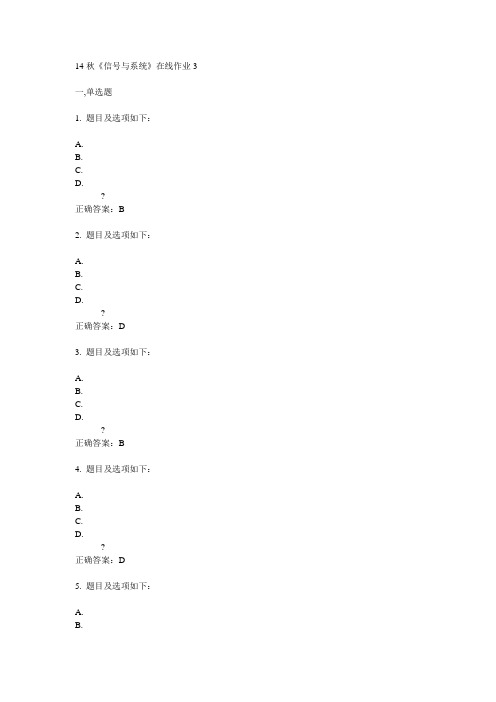
B.虚偶函数的傅里叶级数中不包含正弦项,只可能包含直流项和余弦项
C.实奇函数的傅里叶技术中不包含余弦项和直流项,只可能包含正弦项
D.实奇谐函数的傅里叶级数中只可能包含基波和奇次谐波的正弦、余弦项,而不包含偶次谐波项
?
正确答案:ACD
4.题目及选项如下:
A.若H(z)的全部极点落在单位圆内,则系统稳定
B.若H(z)的全部极点落在单位圆外,则系统稳定
C.若H(z)有极点落于单位圆外,或在单位圆上具有二阶以上的极点,则系统不稳定
D.若H(z)在单位圆上有一阶极点,但其他极点均在单位圆内,则系统临界稳定。
?
正确答案:ACD
3.对于函数的时域对称性与傅里叶系数的关系,下列说法正确的有()。
A.
B.
C.
D.
?
正确答案:B
7.题目及选项如下:
A.
B.
C.
D.
?
正确答案:A
8.对于一个三阶常系数线性微分方程描述的连续时间系统进行系统的时域模拟时,所需积分器数目最少是( )个。
A. 2
B. 3
C. 4
D. 5
?
正确答案:B
9.离散信号f(n)是指()。
A. n的取值是连续的,而f(n)的取值是任意的信号
14秋《信号与系统》在线作业3
一,单选题
1.题目及选项如下:
A.
B.
C.
D.
?
正确答案:B
2.题目及选项如下:
A.
B.
C.
D.
?
正确答案:D
3.题目及选项如下:
A.
B.
中国地质大学(北京)《信号与系统》_在线作业二
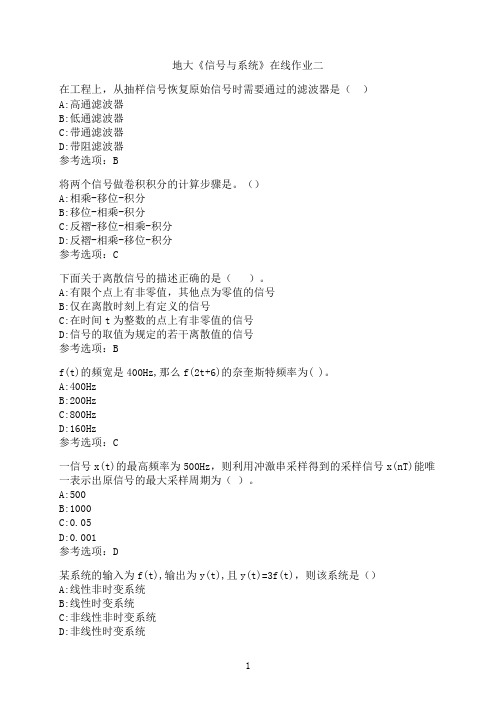
地大《信号与系统》在线作业二在工程上,从抽样信号恢复原始信号时需要通过的滤波器是()A:高通滤波器B:低通滤波器C:带通滤波器D:带阻滤波器参考选项:B将两个信号做卷积积分的计算步骤是。
()A:相乘-移位-积分B:移位-相乘-积分C:反褶-移位-相乘-积分D:反褶-相乘-移位-积分参考选项:C下面关于离散信号的描述正确的是()。
A:有限个点上有非零值,其他点为零值的信号B:仅在离散时刻上有定义的信号C:在时间t为整数的点上有非零值的信号D:信号的取值为规定的若干离散值的信号参考选项:Bf(t)的频宽是400Hz,那么f(2t+6)的奈奎斯特频率为( )。
A:400HzB:200HzC:800HzD:160Hz参考选项:C一信号x(t)的最高频率为500Hz,则利用冲激串采样得到的采样信号x(nT)能唯一表示出原信号的最大采样周期为()。
A:500B:1000C:0.05D:0.001参考选项:D某系统的输入为f(t),输出为y(t),且y(t)=3f(t),则该系统是()A:线性非时变系统B:线性时变系统C:非线性非时变系统D:非线性时变系统参考选项:B使信号通过系统后只产生相位变化,则该系统一定是()。
A:高通滤波网络B:带通滤波网络C:全通网络D:最小相移网络参考选项:C离散线性时不变系统的单位序列响应h(n)为()A:输入为单位冲激信号的零状态响应B:输入为单位阶跃信号的响应C:系统的自由响应D:系统的强迫响应参考选项:A能量信号其()。
A:能量为0B:功率为0C:能量无穷大D:功率无穷大参考选项:B线性系统响应满足以下规律()。
A:若起始状态为零,则零输入响应不一定为零B:若起始状态为零,则零状态响应为零C:若系统的零状态响应为零,则强迫响应也为零D:若激励信号为零,零输入响应就是自由响应参考选项:D如果周期函数满足x(t)=-x(-t),则关于其傅氏级数下列哪项是错误的()。
A:只有余弦项B:只有奇次谐波项C:只有正弦项D:只有偶次谐波项参考选项:A,B,D对于理想低通滤波器,下列说法错误的是()。
信号与系统 第4章-作业参考答案
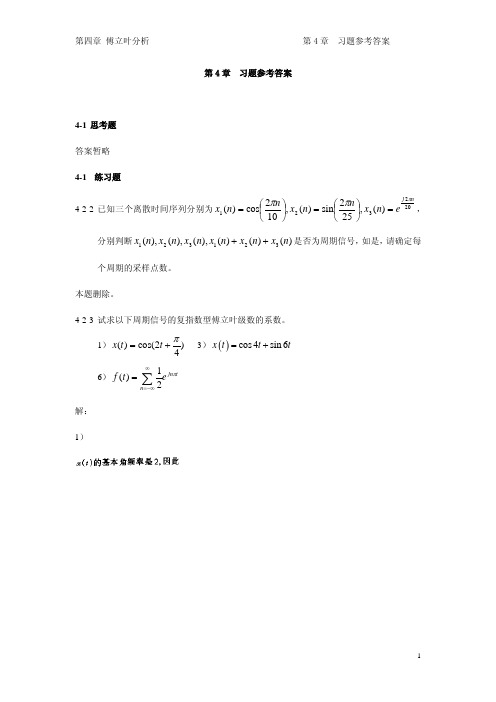
题图 4-3-1 解:
11
第四章 傅立叶分析
第 4 章 习题参考答案
4-3-7
1)x(t)是实周期信号,且周期为 6; 3)x(t) = −x(t − 3)
1 3
设某信号x(t)满足下述条件:
2)x(t)的傅里叶系数为ak ,且当k = 0 和 k > 2时,有ak = 0;
1
4) ∫−3 |x(t)|2dt = 6 2 5)a1是正实数。
第四章 傅立叶分析
第 4 章 习题参考答案
第 4 章 习题参考答案
4-1 思考题 答案暂略 4-1 练习题 4-2-2 已知三个离散时间序列分别为 x1 ( n) = cos
2πn 2πn , x3 (n) = e , x 2 (n) = sin 25 10
π x (t ) = sin 4π t + cos 6π t + 时,试求系统输出 y (t ) 的傅立叶级数。 4
解:
3
第四章 傅立叶分析
第 4 章 习题参考答案
4因果系统: y(t) + 4y(t) = x(t)
式中x(t) 为系统输入,y(t)是系统输出。在下面两种输入条件下,求输出y(t)的傅里叶级数 展开: 1)x(t) = cos2πt ;
2
2
= 3 ) f ( t ) Sa (100t ) + Sa
解:
( 60t ) 4)
sin(4π t ) , −∞ < t < ∞ πt
9
第四章 傅立叶分析
第 4 章 习题参考答案
4)T=1/4 4-2-27 设 x(t ) 是一实值信号,在采样频率 ω s = 10000π 时, x(t ) 可用其样本值唯一确定
信号与系统作业答案郑君里版

信号与系统作业答案郑君里版1.1 1.2 1.3画出信号f(t)sin a(t t0) 的波形。
a(t t0)已知信号f(t) (t 1) u(t 1) u(t 2) ,画出f( 2t 3)的波形。
已知信号f(t) (t 1) u(t 1) u(t 2) ,试求它的直流分量。
答案:01.4 已知信号f(t) (t 1) u(t 1) u(t 2) ,试求它的奇分量和偶分量。
答案:偶分量:0.5(1 t) u(t 2) u(t 1) u(t 1) u(t 1) 0.5(t 1) u(t 1) u(t 2)奇分量:0.5(t 1) u(t 2) u(t 1) t u(t 1) u(t 1) 0.5(t 1) u(t 1) u(t 2)1.5 信号f(t)2 tt 0是否是奇异信号。
t 0答案:二阶以上导数不连续,是奇异信号。
1.6 已知f(t)是有界信号,且当t 时f(t) 0,试问f(t)是否是能量有限信号。
答案:不一定。
1.7 对一连续三角信号进行抽样,每周期抽样8点,求抽样所得离散三角序列的离散角频率。
答案:/41.8 以Ts 0.5s的抽样间隔对下列两个三角信号抽样,写出抽样所得离散序列的表达式,画出它们的波形。
比较和说明两波形的差别,为什么?(1)f1(t) cos4t (2)f2(t) cos15t 4答案:两个离散序列是相同的。
1.9 判断下列信号是否是周期信号。
如果是周期信号,试确定其周期。
(1)f(t) Asin4t Bcos7t Ccos9t 答案:是周期函数,周期T 2 。
(2)fd(n) ejn8答案:是周期信号,周期N 161.10 求下列表达式的函数值(1)(2)(3)(4)(5)(6)(7)f(t t0) (t)dt;答案:f( t0)f(t0 t) (t)dt;答案:f(t0)(t t0)u(t t02)dt;答案:当t0 0时为1;当t0 0时为0 (t t0)u(t 2t0)dt;答案:当t0 0时为1;当t0 0时为0(e t t) (t 2)dt;答案:e2 2 (t sint) (t 6)dt;答案:/6 1/2e j t (2t) (t t0) dt;答案:1/2 e j t01.11 判断下列系统是否线性、时不变和因果de(t);答案:线性,时不变,因果dt(2)r(t) e(t)u(t);答案:线性,时变,因果(1)r(t)(3)r(t) sin e(t) u(t);答案:非线性,时变,因果(4)r(t) e(1 t);答案:线性,时变,非因果(5)r(t) e(2t);答案:线性,时变,非因果(6)r(r) e2(t);答案:非线性,时不变,因果1.12 试证明:f(t) '(t) f(0) '(t) f'(0) (t)。
2018年9月份考试信号与系统第一次作业
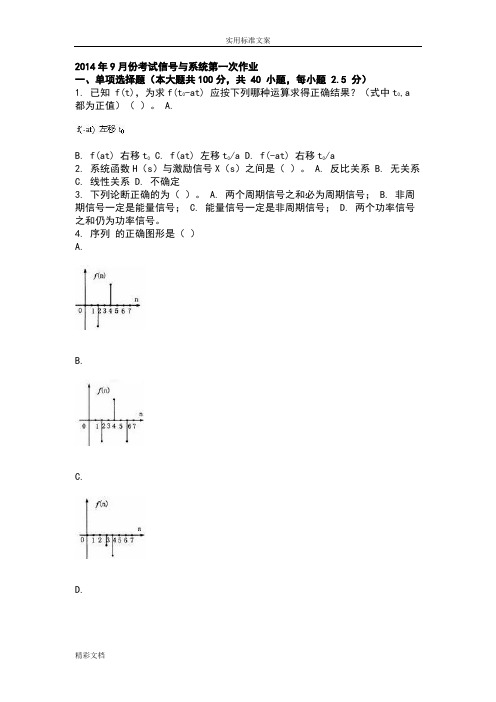
2014年9月份考试信号与系统第一次作业一、单项选择题(本大题共100分,共 40 小题,每小题 2.5 分)1. 已知 f(t),为求f(t0-at) 应按下列哪种运算求得正确结果?(式中t,a都为正值)()。
A.B. f(at) 右移t0 C. f(at) 左移t/a D. f(-at) 右移t/a2. 系统函数H(s)与激励信号X(s)之间是()。
A. 反比关系 B. 无关系C. 线性关系D. 不确定3. 下列论断正确的为()。
A. 两个周期信号之和必为周期信号; B. 非周期信号一定是能量信号; C. 能量信号一定是非周期信号; D. 两个功率信号之和仍为功率信号。
4. 序列的正确图形是()A.B.C.D.5. 已知某系统的系统函数为H(s),唯一决定该系统单位冲激响应h(t)函数形式的是() A. H(s)的零点 B. H(s)的极点 C. 系统的输入信号 D. 系统的输入信号与H(s)的极点6. 信号波形如图所示,设,则为()A. 1B. 2C. 3D. 47. 某信号的频谱密度函数为则f(t) =()。
A.B.C.D.8. 积分等于()A.B.C.D.9. 积分等于()A.B.C.D.10. 信号波形如图所示,设,则为()A. 0B. 1C. 2D. 311. 信号和分别如图(a)和图(b)所示,已知,则的傅里叶变换为()A.B.C.D.12. f(5-2t)是如下运算的结果————————() A. f(-2t)右移5B. f(-2t)左移5C. f(-2t)右移5/2D. f(-2t)左移5/213. 图(b)中与图(a)所示系统等价的系统是()A.B.C.D.14. 若系统的起始状态为0,在x(t)的激励下,所得的响应为———() A. 强迫响应 B. 稳态响应 C. 暂态响应 D. 零状态响应15. 已知信号的傅里叶变换<mml:math xmlns:mml="/1998/Math/MathML" xmlns:m="/officeDocument/2006/math"><mml:mrow ><mml:mi>F</mml:mi><mml:mo>(</mml:mo><mml:mi>j</mml:mi><mml:mi>&omega ;</mml:mi><mml:mo>)</mml:mo><mml:mo>=</mml:mo><mml:mi>δ</mml:mi ><mml:mo>(</mml:mo><mml:mi>ω</mml:mi><mml:mo>−</mml:mo><m ml:msub><mml:mrow><mml:mi>ω</mml:mi></mml:mrow><mml:mrow><mml:m n>0</mml:mn></mml:mrow></mml:msub><mml:mo>)</mml:mo></mml:mrow></mml: math>,则为()A.<mml:math xmlns:mml=" /1998/Math/MathML" xmlns:m=" /officeDocument/2006/math"><mml:mact ionactiontype="link"><mml:mrow><mml:mfrac><mml:mrow><mml:mn>1</mml:mn></ mml:mrow><mml:mrow><mml:mn>2</mml:mn><mml:mi>π</mml:mi></mml:mrow></mml:mfrac><mml:msup><mml:mrow><mml:mi>e</mml:mi ></mml:mrow><mml:mrow><mml:mi>j</mml:mi><mml:msub><mml:mrow><mml:mi>w </mml:mi></mml:mrow><mml:mrow><mml:mn>0</mml:mn></mml:mrow></mml:msub ><mml:mi>t</mml:mi></mml:mrow></mml:msup></mml:mrow></mml:math>B.<mml:math xmlns:mml=" /1998/Math/MathML" xmlns:m=" /officeDocument/2006/math"><mml:mact ionactiontype="link"><mml:mrow><mml:mfrac><mml:mrow><mml:mn>1</mml:mn></ mml:mrow><mml:mrow><mml:mn>2</mml:mn><mml:mi>π</mml:mi></mml:mrow></mml:mfrac><mml:msup><mml:mrow><mml:mi>e</mml:mi ></mml:mrow><mml:mrow><mml:mo>−</mml:mo><mml:mi>j</mml:mi><mml:msub><mml:mrow><mml:mi>w</mml:mi></mm l:mrow><mml:mrow><mml:mn>0</mml:mn></mml:mrow></mml:msub><mml:mi>t</m ml:mi></mml:mrow></mml:msup></mml:mrow></mml:math>C.<mml:math xmlns:mml=" /1998/Math/MathML" xmlns:m=" /officeDocument/2006/math"><mml:mact ionactiontype="link"><mml:mrow><mml:mfrac><mml:mrow><mml:mn>1</mml:mn></ mml:mrow><mml:mrow><mml:mn>2</mml:mn><mml:mi>π</mml:mi></mml:mrow></mml:mfrac><mml:msup><mml:mrow><mml:mi>e</mml:mi ></mml:mrow><mml:mrow><mml:mi>j</mml:mi><mml:msub><mml:mrow><mml:mi>w </mml:mi></mml:mrow><mml:mrow><mml:mn>0</mml:mn></mml:mrow></mml:msub ><mml:mi>t</mml:mi></mml:mrow></mml:msup><mml:mi>ξ</mml:mi><mml:mrow><mml:mo>(</mml:mo><mml:mi>t</mml:mi><mml:mo>)</mml :mo></mml:mrow></mml:mrow></mml:math>D.<mml:math xmlns:mml=" /1998/Math/MathML" xmlns:m=" /officeDocument/2006/math"><mml:mact ionactiontype="link"><mml:mrow><mml:mfrac><mml:mrow><mml:mn>1</mml:mn></ mml:mrow><mml:mrow><mml:mn>2</mml:mn><mml:mi>π</mml:mi></mml:mrow></mml:mfrac><mml:msup><mml:mrow><mml:mi>e</mml:mi ></mml:mrow><mml:mrow><mml:mo>−</mml:mo><mml:mi>j</mml:mi><mml:msub><mml:mrow><mml:mi>w</mml:mi></mm l:mrow><mml:mrow><mml:mn>0</mml:mn></mml:mrow></mml:msub><mml:mi>t</m ml:mi></mml:mrow></mml:msup><mml:mi>ξ</mml:mi><mml:mrow><mml:mo>(</mml:mo><mml:mi>t</mml:mi><mml:mo>)</mml :mo></mml:mrow></mml:mrow></mml:math>16. 离散信号f(n)是指()A. n的取值是连续的,而f(n)的取值是任意的信号B. n的取值是离散的,而f(n)的取值是任意的信号C. n的取值是连续的,而f(n)的取值是连续的信号D. n的取值是连续的,而f(n)的取值是离散的信号17. 连续信号与的卷积,即()A. f(t)B. f(t-t) C.D.18. 信号的拉氏变换及收敛域为()A.B.C.D.19. 若序列f(n)的图形如图(a)所示,那么f(-n+1)的图形为图(b)中的()A.B.C.D.20. 的拉氏反变换为()A.B.C.D.21. 若周期信号 f(t)是时间 t的奇函数,则其三角形傅里叶级数展开式中只含( )。
西南大学21春[1073]《信号与系统》作业答案
![西南大学21春[1073]《信号与系统》作业答案](https://img.taocdn.com/s3/m/d03a7839d15abe23492f4d9e.png)
1073 20211单项选择题1、设是信号的傅里叶变换,的波形如图所示,则等于()。
1.4pi2.2pi3.6pi4.02、完整表示对理想滤波器的逼近,可以采用()1.误差容限图2.阻带最小衰减3.对模拟与数字滤波器要区别对待4.通带内最大误差3、冲激函数的单边(下限规定为从0-时刻开始)拉氏变换为1.js2.03.s4.14、下列滤波器中,通带最平坦的是()1.巴特沃思2.贝塞尔滤波器3.椭圆滤波器4.切比雪夫5、等于()1. F. 12.03.e^-54.e^-16、()1.f(-1)2.f(1)3.04.f(0)7、已知信号x(t)的傅里叶变换为,则信号y(t)的频谱为()。
1.R(w)cos(w)2.R(w)/23.R(w/2)4.R(w)8、关于抽样,下列说法错误的是()1. E. 理想的冲激采样可表示零阶保持抽样,二者的频谱变化是一致的。
2.时域抽样,频域会产生周期延拓3.频域抽样,时域会产生周期延拓4.由时域抽样可知,序列的频谱是周期连续的频谱9、已知,则等于()1.2pi2.03.1/24.110、周期信号的波形如图所示,则其傅里叶级数中含有()。
1.正弦分量与余弦分量2.直流分量与正弦分量3.奇次谐波分量4.直流分量与余弦分量11、从S域到Z域的映射中,为保证映射前后滤波器的稳定性不变,则应满足()1.s域左半平面映射到z域的单位圆内,虚轴到单位圆外2.s域左半平面映射到z域的单位圆外,虚轴到单位圆内3.s域左半平面映射到z域的单位圆外部,虚轴到单位圆4.s域左半平面映射到z域的单位圆内,虚轴到单位圆12、关于傅里叶变换,时域做虚指数加权,频域()1.左移2.尺度3.右移4.平移13、已知二端口网络如下图所示,则该系统为()。
1.带阻2.带通3.低通4.高通判断题14、抽样函数可简写为Sa(t)=sin(t)/t,是偶对称的函数。
1. A.√2. B.×15、连续信号的移位、翻转、尺度等运算,都是针对独立变量t而言。
[信号与系统作业解答]第三章
![[信号与系统作业解答]第三章](https://img.taocdn.com/s3/m/4cd40f1ca8114431b90dd8da.png)
3-4 求下图所示周期三角信号的傅里叶级数(三角形式)。
解:从图中可知,周期信号的在[ T / 2,T / 2] 的表达式为
f (t)
2E T
t,
0
t
T /2
2E T
t
T /2 t 0
周期为T ,基频 0
2 T。
1)三角形式的傅里叶级数
f (t) a0
[an cos(n 0t) bn sin(n 0t)]
解:
f (t)cos( 0t)
F1( )
1 2
[F(
0) F(
0 )]
f (t)e j 0t F2( ) F(
0)
f (t)cos( 1t)
F3( )
1 2
[F(
1) F(
1)]
3-39 确定下列信号的最低抽样率与奈奎斯特间隔。
(1) Sa(100t )
(3)Sa(100t) Sa(50t)
解:(1)因为Sa(100t) 50G200( ) ,最高频率为 m 100 rad / s ,所以最低抽样
所以
F [fo(t)] 1 [F( ) 2
1 2F
[f (t)
F *( )]
f *( t)] j Im[F( )]
(2)因为 fr (t)
1 2
[f
(t)
f *(t)] ,
所以
F [fr (t)]
1 2F
[f (t)
f *(t)]
1 [F( ) F *( 2
)]
同样的, fi (t)
1 [f (t) 2j
1因为20010050sa最高频率为100所以最低抽样频率为2002又因为另一个分量1005025sa最高频率为100所以最低抽样频率为200341系统如图所示求最大抽样间隔max100020003000300030001000200010001000300010003000波形如下图所示可知的最高频率为3000要进行无失真的恢复则最低抽样频率为min6000对应的最大抽样间隔为maxmin波形如下图所示其中
[答案][北京交通大学]《信号与系统》在线作业二
![[答案][北京交通大学]《信号与系统》在线作业二](https://img.taocdn.com/s3/m/4b1e6c6f65ce05087732133a.png)
1.在工程上,从抽样信号恢复原始信号时需要通过的滤波器是()。
[答案:B]A.高通滤波器B.低通滤波器C.带通滤波器D.带阻滤波器2.当输入信号的复频率等于系统函数的零点时,系统的强迫响应分量为()。
[答案:C]A.无穷大B.不为零的常数C.0D.随输入信号而定3.信号的时宽与信号的频宽之间呈()。
[答案:B]A.正比关系B.反比关系C.平方关系D.没有关系4.离散时间单位延迟器D的单位序列响应为()。
[答案:C]A.δ(k)B.δ(k+1)C.δ(k-1)D.15.信号f(t)=3cos(4t+π/3)的周期是()。
[答案:C]A.2πB.πC.π/2D.π/46.线性系统具有()。
[答案:D]A.分解特性B.零状态线性C.零输入线性D.以上全对7.零输入响应是()。
[答案:B]A.全部自由响应B.部分自由响应C.部分零状态响应D.全响应与强迫响应之差8.Sa[π(t-4)]δ(t-4)等于()。
[答案:A]A.δ(t-4)B.sinπ(t-4)C.1D.09.欲使信号通过系统后只产生相位变化,则该系统一定是()。
[答案:C]A.高通滤波网络B.带通滤波网络C.全通网络D.最小相移网络10.设系统零状态响应与激励的关系是:yzs(t)=|f(t)|,则以下表述不对的是()。
[答案:A]A.系统是线性的B.系统是时不变的C.系统是因果的D.系统是稳定的11.若一个连续LTI系统是因果系统,它一定是一个稳定系统。
()[答案:A]A.错误B.正确12.稳定系统的H(s)极点一定在s平面的左半平面。
()[答案:A]A.错误B.正确13.一个因果的稳定系统的系统函数所有的零、极点必须都在s平面的左半平面内。
()[答案:A]A.错误B.正确14.对连续周期信号取样所得的离散时间序列也是周期信号。
()[答案:A]A.错误B.正确15.两个非线性系统的级联构成的系统也是非线性的。
()[答案:A]A.错误B.正确16.两个线性时不变系统的级联构成的系统是线性时不变的。
信号与系统 第6章-作业参考答案

Hd
(z)
=
Hc(z)
s
=1− 1+
z z
−1 −1
证明:H������(z)有一个位于单位圆内的极点和一个位于单位圆外的零点
c)对于系统函数H������(z),证明�H�������ejω�� = 1
证明:
16
第六章 z 变换
第 6 章 习题参考答案
6-4 计算机设计题 答案暂略
17
和 x2(n) = �14�n u(n)
设序列x1(n)的单边和双边 变换分别为 X1( X2(z) 和 X2d (z) 。
1) 根据双边 z 变换的定义和卷积定理,求出g(n) = x1(n) ∗ x2(n); 2) 根据单边 z 变换的定义和卷积定理,求出g(n) = x1(n) ∗ x2(n); 3) 解释 1)和 2)的结果为何不同。 解:
,试用
z
变换的初值
和终值性质确定离散序列 x(n) 的初值 x(0) 和终值 x(∞) 。
6
第六章 z 变换 解:直接求出。
第 6 章 习题参考答案
6-2-26 某离散LTI系统由差分方程
y(n)
−
10 3
y(n)
+
y(n
+
1)
=
x(n)
描述。试求系统的单位样值响应 h(n) ,并确定系统的稳定性。
解:
5
第六章 z 变换
第 6 章 习题参考答案
∞
∑ 6-2-21 序列 x(n) 的自相关序列定义为φxx (n) = x(k)x(n + k) 。试利用 x(n) 的 z 变换 k =−∞
求出φxx (n) 的 z 变换。
解:
- 1、下载文档前请自行甄别文档内容的完整性,平台不提供额外的编辑、内容补充、找答案等附加服务。
- 2、"仅部分预览"的文档,不可在线预览部分如存在完整性等问题,可反馈申请退款(可完整预览的文档不适用该条件!)。
- 3、如文档侵犯您的权益,请联系客服反馈,我们会尽快为您处理(人工客服工作时间:9:00-18:30)。
Signals and SystemChap11.6 Determine whether or not each of the following signals is periodic: (a): (/4)1()2()j t x t e u t π+= (b): 2[][][]x n u n u n =+- (c): 3[]{[4][14]}k x n n k n k δδ∞=-∞=----∑1.9 Determine whether or not each of the following signals is periodic, If a signal is periodic , specify its fundamental period:(a): 101()j t x t je = (b): (1)2()j t x t e -+= (c):73[]j n x n e π=(d): 3(1/2)/54[]3j n x n e π+= (e): 3/5(1/2)5[]3j n x n e += 1.14 considera periodic signal 1,01()2,12t x t t ≤≤⎧=⎨-<<⎩with period T=2. Thederivative of this signal is related to the “impulse train”()(2)k g t t k δ∞=-∞=-∑,with period T=2. It can be shown that 1122()()()dx t A g t t A g t t dt=-+-. Determine the values of 1A , 1t , 2A , 2t .1.15.Consider a system S with input x[n] and output y[n].This system is obtained through a series interconnection of a system S 1 followed by a system S2. The input-output relationships for S 1 and S 2 are S 1: ],1[4][2][111-+=n x n x n y S 2: ]3[21]2[][222-+-=n x n x n yWhere ][1n x and ][2n x denote input signals.(a) Determine the input-output relationship for system S.(b)Does the input-output relationship of system S change if the order in which S 1 and S 2 are connected in series is reversed(i e ,if S 2 follows S 1)? 1.16.Consider a discrete-time system with input x[n] and output y[n].The input-output relationship for this system is]2[][][-=n x n x n y(a) Is the system memoryless?(b) Determine the output of the system when the input is ][n A δ, where A is any real or complex number. (c) Is the system invertible?1.17.Consider a continuous-time system with input x(t) and output y(t) related by))(sin()(t x t y =(a) Is this system causal? (b) Is this system linear?1.21.A continous-time signal ()x t is shown in Figure P1.21. Sketch and label carefully each of the following signals:(a): (1)x t - (b): (2)x t - (c): (21)x t + (d): (4/2)x t - (e): [()()]()x t x t u t +- (f):()[(3/2)(3/2)]x t t t δδ+--1.22. A discrete-time signal ()x t is shown in Figure P1.22. Sketch andlabel carefully each of the following signals:(a): [4]x n - (b): [3]x n - (c): [3]x n (d): [31]x n + (e): [][3]x n u n - (f): [2][2]x n n δ-- (g):11[](1)[]22n x n x n +- (h): 2[(1)]x n - 1.25.Determine whether or not each of the following continuous-time signals is periodic. If the signal is periodic, determine its fundamental period.(a): ()3cos(4)3x t t π=+ (b): (1)()j t x t e π-= (c):2()[cos(2)]3x t t π=-(d): (){cos(4)()}x t t u t ενπ= (e): (){sin(4)()}x t t u t ενπ= (f): (2)()t n n x t e∞--=-∞=∑1.26. Determine whether or not each of the following discrete-time signals is periodic. If the signal is periodic, determine its fundamental period. (a):6[]sin(1)7x n n π=+ (b): []cos()8nx n π=- (c): 2[]cos()8x n n π= (d):[]cos()cos()24x n n n ππ=(e):[]2cos()sin()2cos()4826x n n n n ππππ=+-+Chap 22.1 Let]3[]1[2][][---+=n n n n x δδδ and ]1[2]1[2][-++=n n n h δδCompute and plot each of the following convolutions: (a)][*][][1n h n x n y = (b)][*]2[][2n h n x n y += (c)]2[*][][3+=n h n x n y2.3 Consider an input x[n] and a unit impulse response h[n] given by],2[)21(][2-=-n u n x n].2[][+=n u n hDetermine and plot the output ].[*][][n h n x n y = 2.7 A linear system S has the relationship[][][2]k y n x k g n k ∞=-∞=-∑Between its input x[n] and its output y[n], where g[n]=u[n]-u[n-4]. (a) Determine y[n] where ]1[][-=n n x δ (b) Determine y[n] where ]2[][-=n n x δ (c) Is S LTI?(d) Determine y[n] when x[n]=u[n] 2.10 Suppose that⎩⎨⎧≤≤=elsewhere t t x ,010,1)( And )/()(αt x t h =,where 10≤<α.(a) Determine and sketch )(*)()(t h t x t y =(b) If dt t dy /)( contains only three discontinuities, what is the value ofα?2.11 Let)5()3()(---=t u t u t x and )()(3t u e t h t -=(a) Compute )(*)()(t h t x t y =. (b) Compute )(*)/)(()(t h dt t dx t g =. (c) How is g(t) related to y(t)? 2.20 Evaluate the following integrals: (adt t t u )cos()(0⎰∞∞-(b)⎰+50)3()2sin(dt t t δπ (c)⎰--551)2cos()1(τπττd u2.27 We define the area under a continuous-time signal )(t v as⎰∞∞-=dt t v A v )(Show that if )(*)()(t h t x t y =, thenh x y A A A =2.40 (a) an LTI system with input and output related through the equationτττd x e t y tt )2()()(-=⎰∞---What is the impulse response h(t) for this system?(b) Determine the response of the system when the input x(t) is as shown in Figure P2.40.Chap 33.1 A continuous-time periodic signal x(t) is real value and has a fundamental period T=8. The nonzero Fourier series coefficients for x(t) arej a a a a 4,2*3311====--.Express x(t) in the form)cos()(0k k k k t A t x φω+=∑∞=3.2 A discrete-time periodic signal x[n] is real valued and has a fundamental period N=5.The nonzero Fourier series coefficients for x[n] are10=a ,4/2πj e a --=,4/2πj e a =,3/*442πj ea a ==- Express x[n] in the form)sin(][10k k k k n A A n x φω++=∑∞=3.3 For the continuous-time periodic signal)35sin(4)32cos(2)(t t t x ππ++= Determine the fundamental frequency 0ω and the Fourier series coefficients k a such thattjk k kea t x 0)(ω∑∞-∞==.3.5 Let 1()x t be a continuous-time periodic signal with fundamental frequency 1ω and Fourier coefficients k a . Given that211()(1)(1)x t x t x t =-+-How is the fundamental frequency 2ω of 2()x t related to ?Also, find a relationship between the Fourier series coefficients k b of 2()x t and the coefficients k a You may use the properties listed in Table 3.1. 3.8 Suppose we are given the following information about a signal x(t): 1. x(t) is real and odd.2. x(t) is periodic with period T=2 and has Fourier coefficients k a .3. 0=k a for 0||>k .4 1|)(|21202=⎰dt t x .Specify two different signals that satisfy these conditions.3.13 Consider a continuous-time LTI system whose frequency response is⎰∞∞--==ωωωω)4sin()()(dt e t h j H t jIf the input to this system is a periodic signal⎩⎨⎧<≤-<≤=84,140,1)(t t t x With period T=8,determine the corresponding system output y(t). 3.15 Consider a continuous-time ideal lowpass filter S whose frequency response is1, (100)()0, (100)H j ωωω⎧≤⎪=⎨>⎪⎩When the input to this filter is a signal x(t) with fundamental period6/π=T and Fourier series coefficients k a , it is found that)()()(t x t y t x S=→.For what values of k is it guaranteed that 0=k a ?3.35.Consider a continuous-time LTI system S whose frequency response is 1,||250()0,H j otherwise ωω≥⎧=⎨⎩When the input to this system is a signal x(t) with fundamental period/7T π= and Fourier series coefficients k a ,it is found that the output y(t)is identical to x(t).For what values of k is it guaranteed that 0k a =?Chap 44.1 Use the Fourier transform analysis equation(4.9)to calculate the Fourier transforms of;(a))1()1(2---t u e t (b)|1|2--t eSketch and label the magnitude of each Fourier transform.4.2 Use the Fourier transform analysis equation(4.9) to calculate the Fourier transforms of: (a))1()1(-++t t δδ (b))}2()2({-+--t u t u dtdSketch and label the magnitude of each Fourier transform.4.5 Use the Fourier transform synthesis equation(4.8) to determine the inverse Fourier transform of ()()|()|j X j X j X j e ωωω= ,where|()|2{(3)(3)}X j u u ωωω=+-- 3()2X j ωωπ=-+Use your answer to determine the values of t for which x(t)=0. 4.6 Given that x(t) has the Fourier transform ()X j ω, express the Fourier transforms of the signals listed below in the terms of ()X j ω.You may find useful the Fourier transform properties listed in Table4.1. (a))1()1()(1t x t x t x --+-= (b))63()(2-=t x t x(c) )1()(223-=t x dtd t x4.11 Given the relationships)()()(t h t x t y *=And)3()3()(t h t x t g *=And given that x(t) has Fourier transform )(ωj X and h(t) has Fouriertransform )(ωj H ,use Fourier transform properties to show that g(t) has the form)()(Bt Ay t g =Determine the values of A and B.4.13 Let x(t) be a signal whose Fourier transform is()()()(5)X j ωδωδωπδω=+-+-And let()()(2)h t u t u t =--(a) Is x(t) periodic? (b) Is ()*()x t h t periodic?(c) Can the convolution of two aperiodic signals be periodic?4.14 Consider a signal x(t) with Fourier transform )(ωj X .Suppose we are given the following facts: 1. x(t) is real and nonnegative.2. ),()}()1{21t u Ae j X j F t --=+ωωwhere A is independent of t.3.⎰∞∞-=πωω2|)(|d j X .Determine a closed-form expression for x(t).Chap 66.1 Consider a continuous-time LTI system with frequency response()()|()|H j H j H j e ωωω= and real impulse response h(t). Supposethat we apply an input 00()cos()x t t ωφ=+ to this system .Theresulting output can be shown to be of the form0()()y t Ax t t =-Where A is a nonnegative real number representing an amplitude-scaling factor and 0t is a time delay.(a)Express A in terms of |()|H j ω.(b)Express 0t in terms of 0()H j ω6.3 Consider the following frequency response for a causal and stable LTI system:1()1j H j j ωωω-=+ (a) Show that |()|H j A ω=,and determine the values of A.(b)Determine which of the following statements is true about ()τω,the group delay of the system.(Note ()(())/d H j d τωωω=- ,where ()H j ω is expressed in a form that does not contain any discontinuities.)1.()0 0for τωω=>2.()0 0for τωω>>3 ()0 0for τωω<>6.5 Consider a continuous-time ideal bandpass filter whose frequency response is⎩⎨⎧≤≤=elsewherej H c c ,03||,1)(ωωωω (a) If h(t) is the impulse response of this filter, determine a function g(t)such that)(sin )(t g tt t h c πω= (b) As c ω is increased, dose the impulse response of the filter get moreconcentrated or less concentrated about the origin?Chap 77.1 A real-valued signal x(t) is know to be uniquely determined by its samples when the sampling frequency is 10,000s ωπ=.For what values of ω is ()X j ω guaranteed to be zero?7.2 A continuous-time signal x(t) is obtained at the output of an ideal lowpass filter with cutoff frequency 1,000c ωπ=.If impulse-train sampling is performed on x(t), which of the following sampling periods would guarantee that x(t) can be recovered from its sampled version using an appropriate lowpass filter?(a) 30.510T -=⨯(b) 3210T -=⨯(c) 410T -=7.3 The frequency which, under the sampling theorem, must be exceeded by the sampling frequency is called the Nyquist rate. Determine the Nyquist rate corresponding to each of the following signals:(a)()1cos(2,000)sin(4,000)x t t t ππ=++ (b)sin(4,000)()t x t tππ=(c) 2sin(4,000)()()t x t t ππ= 7.4 Let x(t) be a signal with Nyquist rate 0ω. Determine the Nyquist ratefor each of the following signals:(a)()(1)x t x t +- (b)()dx t dt(c)2()x t(d)0()cos x t t ω 7.9 Consider the signal2sin 50()()t x t tππ= Which we wish to sample with a sampling frequency of 150s ωπ= to obtain a signal g(t) with Fourier transform ()G j ω.Determine the maximum value of 0ω for which it is guaranteed that0()75() ||G j X j for ωωωω=≤Where ()X j ω is the Fourier transform of x(t).Chap 88.1 Let x(t) be a signal for which M ()0 when ||> X j ωωω=.Another signal y(t) is specified as having the Fourier transform ()2(())c Y j X j ωωω=-.Determine a signal m(t) such that8.3 Let x(t) be a real-valued signal for which()0 ||2,000X j when ωωπ=>.Amplitude modulation is performed toproduce the signal()()sin(2,000)g t x t t π=A proposed demodulation technique is illustrated in Figure P8.3 where g(t) is the input, y(t) is the output, and the ideal lowpass filter has cutoff frequency 2,000πand passband gain of 2. Determine y(t).FigureP8.38.22 In Figure P8.22(a), a system is shown with input signal x(t) and output signal y(t).The input signal has the Fourier transform ()X j ω shown in Figure P8.22(b). Determine and sketch ()Y j ω, the spectrum of y(t).8.28 In Section 8.4 we discussed the implementation of single-sideband modulation using 090 phase-shift networks, and in Figure8.21 and 8.22 we specifically illustrated the system and associated()()()x t y t m t =spectra required to retain the lower sidebands.Figure P8.28(a) shows the corresponding system required to retain the upper sidebands.(a) With the same ()X j ω illustrated in Figure8.22, sketch12(),()Y j Y j ωω,and ()Y j ω for the system in FigureP8.28(a), and demonstrate that only the upper sidebands are retained.(b) F or ()X j ω imaginary, as illustrated in FigureP8.28(b), sketch12(),()Y j Y j ωω and ()Y j ω for the system in FigureP8.28(a), and demonstrate that , for this case also, only the upper sidebands are retained.Chap 99.2 Consider the signal 5()(1)t x t e u t -=- and denote its Laplace transform by X(s).(a)Using eq.(9.3),evaluate X(s) and specify its region of convergence. (b)Determine the values of the finite numbers A and 0t such that theLaplace transform G(s) of 50()()t g t Ae u t t -=-- has the same algebraic form as X(s).what is the region of convergence corresponding to G(s)?9.5 For each of the following algebraic expressions for the Laplace transform of a signal, determine the number of zeros located in the finite s-plane and the number of zeros located at infinity: (a)1113s s +++ (b) 211s s +- (c) 3211s s s -++9.7 How many signals have a Laplace transform that may be expressed as2(1)(2)(3)(1)s s s s s -++++ in its region of convergence? Solution:There are 4 poles in the expression, but only 3 of them have different real part.∴ The s-plane will be divided into 4 strips which parallel to the jw-axis and have no cut-across.∴ There are 4 signals having the same Laplace transform expression.9.8 Let x(t) be a signal that has a rational Laplace transform with exactly two poles located at s=-1 and s=-3. If 2()() ()t g t e x t and G j ω=[ the Fourier transform of g(t)] converges, determine whether x(t) is left sided, right sided, or two sided. 9.9 Given that1(),{}Re{}sat e u t Re s a s a -↔>-+ Determine the inverse Laplace transform of22(2)(),Re{}3712s X s s s s +=>-++ 9.10 Using geometric evaluation of the magnitude of the Fourier transform from the corresponding pole-zero plot ,determine, for each of the following Laplace transforms, whether the magnitude of the corresponding Fourier transform is approximately lowpass, highpass, or bandpass. (a): 11(),{}1(2)(3)H s e s s s =ℜ>-++ (b): 221(),{}12s H s e s s s =ℜ>-++ (c): 232(),{}121s H s e s s s =ℜ>-++ 9.13 Let ()()()g t x t x t α=+- ,Where ()()t x t e u t β-=. And the Laplace transform of g(t) is 2(),1{}11s G s e s s =-<ℜ<-. Determine the values of the constants αand β.。
